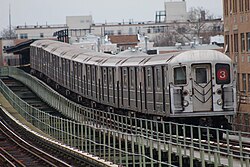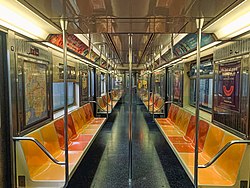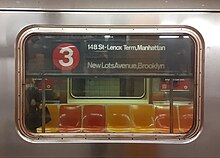
The 7 Flushing Local and <7> Flushing Express are two rapid transit services in the A Division of the New York City Subway, providing local and express services along the full length of the IRT Flushing Line. Their route emblems, or "bullets", are colored purple, since they serve the Flushing Line.

The R32 was a New York City Subway car model built by the Budd Company from 1964 to 1965 for the IND/BMT B Division. A total of 600 R32s were built, numbered 3350–3949, though some cars were re-numbered. The R32 contract was divided into two subcontracts of 300 cars each: R32 and R32A ; the former was paid by the city's capital budget and the latter was paid through a revenue bond. All were arranged as married pairs.

The R142 is the first mass-produced model class of the newest generation or new technology (NTT) A Division cars for the New York City Subway. It was built by Bombardier Transportation in La Pocatière, Quebec, Canada and Barre, Vermont, U.S. with final assembly performed at Plattsburgh, New York, from 1999 to 2003. There are 880 cars numbered 6301–7180 and another 150 cars numbered 1101–1250, for a total of 1,030 cars, all arranged as five-car sets. Together with the R142As, they replaced the Redbird trains, including the R26, R28, R29, R33, R33S, and R36.

The R142A is the second order of new technology cars (NTTs) for the A Division of the New York City Subway. These cars were built by Kawasaki Heavy Industries in the U.S. at Yonkers, New York and Lincoln, Nebraska, and in Japan at Kobe, Hyōgo. They replaced the Redbird trains, including the R26, R28, R29, R33, R33S, and R36. The R142A fleet initially comprised 600 cars, arranged as five-car units.

The New York City Subway is a large rapid transit system and has a large fleet of rolling stock. As of November 2016, the New York City Subway has 6418 cars on the roster.

The New York City Subway is a rapid transit system that serves four of the five boroughs of New York City, New York: the Bronx, Brooklyn, Manhattan, and Queens. Its operator is the New York City Transit Authority (NYCTA), which is controlled by the Metropolitan Transportation Authority (MTA) of New York. In 2016, an average of 5.66 million passengers used the system daily, making it the busiest rapid transit system in the United States and the seventh busiest in the world.

The R68A is a B Division New York City Subway car order consisting of 200 cars built between 1988 and 1989 by Kawasaki Railcar Company in Kobe, Japan, with final assembly done at the Kawasaki plant in Yonkers, New York. A total of 200 cars were built, arranged in four-car sets.

The R110A was a New York City Subway car model built by Kawasaki Heavy Industries in 1992 as a prototype New Technology Train to test various technologies. There were ten cars arranged as five-car sets. They were designed to test features that would be implemented on future mass-production New Tech Train orders.
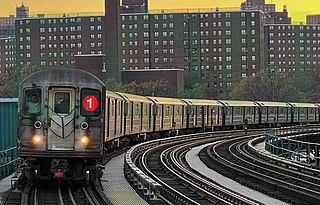
The R62A is a New York City Subway car model built between 1984 and 1987 by Bombardier Transportation for the A Division. The cars were built in La Pocatière, Quebec, with final assembly done in Auburn, New York and Barre, Vermont, under a license from Kawasaki Heavy Industries, manufacturer of the previous R62 order. A total of 825 cars were built, arranged as sets of three, four, or five cars per set. The cars replaced the remaining R17s, R21s, and R22s, which were all retired by early 1988.
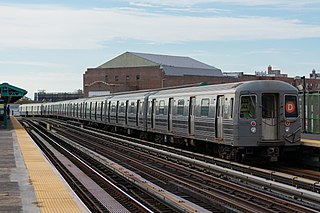
The R68 is a B Division New York City Subway car order consisting of 425 cars built by the Westinghouse-Amrail Company, a joint venture of Westinghouse, ANF Industrie, Jeumont Schneider, and Alsthom. The cars were built in France from 1986 to 1988 and shipped through New York Harbor. Of the cars in the fleet, 416 are arranged in four-car sets while the other nine are single cars.
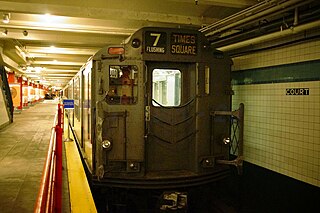
The R12 was a New York City Subway car built by the American Car and Foundry Company in 1948. A total of 100 cars were built, arranged as single units. Two versions were manufactured: Westinghouse (WH)-powered cars and General Electric (GE)-powered cars.

The R21 was a New York City Subway car built by St. Louis Car Company from 1956 to 1957 for the IRT A Division. A total of 250 cars were built, arranged as single units. Two versions were manufactured: Westinghouse (WH)-powered cars and General Electric (GE)-powered cars.

The Franklin Street station is a local station on the IRT Broadway–Seventh Avenue Line of the New York City Subway, located at the intersection of Franklin Street, Varick Street, and West Broadway. It is served by the 1 train at all times and by the 2 train during late nights.

The 18th Street station is a local station on the IRT Broadway–Seventh Avenue Line of the New York City Subway. Located at the intersection of 18th Street and Seventh Avenue in Manhattan, it is served by the 1 train at all times and by the 2 train during late nights.

The R188 is a class of new technology (NTT) New York City Subway cars built by Kawasaki Heavy Industries for the A Division. The fleet entered service in 2013, displacing the 1980s-era R62A cars that operated on the 7 and <7> services, in conjunction with the automation of the IRT Flushing Line's signal system with communications-based train control (CBTC). The R188 order also expanded the 7's fleet as part of the 7 Subway Extension, which opened in 2015.
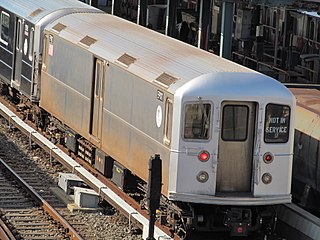
The R127 and R134 are New York City Subway cars purpose-built by Kawasaki Heavy Industries in Kobe, Japan for work train service. The ten R127s, numbered EP001 to EP010, were built in 1990–1991 while the eight R134s, numbered EP011 to EP018, were built in 1994–1996.
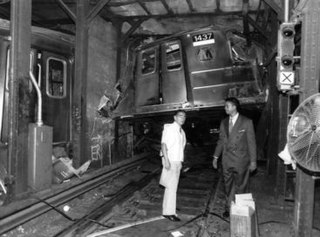
On August 28, 1991, a 4 Lexington Avenue Express train on the New York City Subway's IRT Lexington Avenue Line derailed as it was about to enter 14th Street–Union Square station, killing five people. It was the worst accident on the subway system since the 1928 Times Square derailment. The motorman was found at fault for alcohol intoxication and excessive speed, and served time in prison for manslaughter.
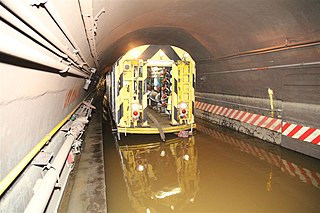
The R65s are New York City Subway work service cars built around 1989 by Kawasaki Heavy Industries in Kobe, Japan. They are similar-looking to the R62 and R62A passenger cars and built to IRT specifications, but can be found on either division. They are numbered PC01–PC03 and used to pump out water from flooded tunnels and open cut areas. Unlike their revenue service counterparts, the R65s cannot move under their own power; they are always propelled by diesel locomotives.

New Technology Train (NTT) is the collective term for the modern passenger fleet of the New York City Subway that has entered service since the turn of the 21st century. This includes the current R142, R142A, R143, R160, R179, R188 and R211 models, along with the planned R262 and R268 models. Two prototypes, the R110A and R110B, were used to test the features that would be found on all NTT trains today.

The R262 is a proposed New Technology Train-series subway car for the New York City Subway. It is expected to replace the current R62 and R62A rolling stock, which are used on the subway's A Division and were built in the mid-1980s.
